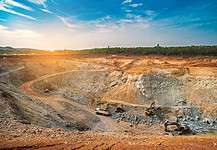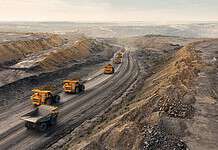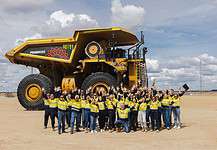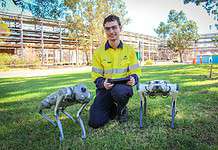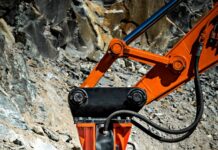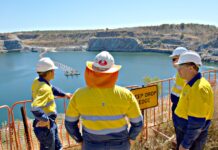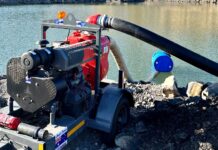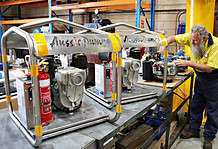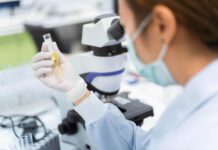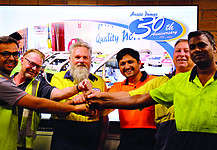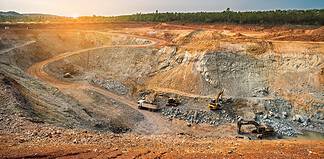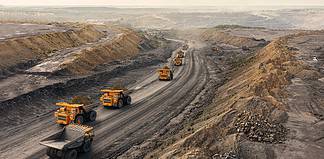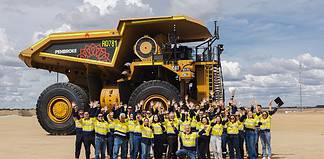ADAM Technology specialises in innovative, precision measuring systems for remote 3D measurement using digital photogrammetry.
The company has spent the past 25 years developing photogrammetric systems, culminating in its 3D Dynamic Measurement (3DM) Analyst software, which is now used all over the world by surveying companies, mapping organisations, geotechnical consultants, mining companies, universities, government departments, and many others, for applications as varied as denture wear measurement, dinosaur footprint modelling, geotechnical analysis, and aerial mapping with UAVs.
The remote sensing technology is unique in that the accuracy is highly customisable compared to laser scanning, where the accuracy of the equipment is fixed and pre-set at the manufacturing stage.
ADAM Technology managing director Jason Birch said almost any accuracy can be achieved with photogrammetry.
“If you think about making a 3D model of a $1 coin, you can take photographs where every pixel on the image represents a few square microns on the coin,” Mr Birch said.
“That is going to be far more detailed and far more accurate than if you photographed the coin from a kilometre away with the same lens and every pixel represented 10 cm.
“The accuracy of photogrammetry is directly related to how big the pixels are on the surface as well as the relationship between the camera positions, and the size of the pixels on the surface can be easily adjusted using the distance of the camera and the focal length of the lens.
“It’s relatively straightforward just using off-the-shelf cameras and lenses to achieve accuracies that even the best laser scanners would have difficulty matching.”
Because the technology is based on photography, it has a wide range of applications for mining operations.
“All you have to be able to do it have at least two images from at least two different locations,” Mr Birch said.
“If the scene is not changing, like a typical pit wall, then you can just use a single camera and move it around.
“If the thing you’re taking photos of is actually changing in real time, then you would have two or more cameras and trigger them simultaneously so you capture it at the same time in each camera and then you can create a 3D model.”
Aerial applications
ADAM Technology pioneered the use of UAVs for aerial photogrammetry in the mid- to late 2000s.
For mine stockpiles, using a drone or UAV that can fly over and capture images from above is far simpler and more cost-effective than other approaches.
For much larger areas, like exploration for a potential open pit mine, a conventional aircraft can be more cost-effective than a drone – but the technology is both accurate and efficient regardless of the areas photographed.
“For example, for a stockpile that’s 1 km long by 350m across, to fly that stockpile takes around 12 minutes and to process the images around seven to eight minutes – so 20 minutes in total to do a stockpile that’s a third of a square kilometre,” Mr Birch said.
“It’s actually very fast, and the quality of the data is actually very high compared to other technologies.”
Mr Birch said the typical accuracy for UAV projects is between 20-50mm.
“For a drone flown at 120 m altitude, travelling at 36km an hour, you can capture a few hundred images in very little time and achieve 20-30mm accuracy without much difficultly at all,” he said.
“For something like a stockpile that is drawn down from below creating inverted cones, you really want a vantage point that is above it; flying over it to collect all that data is far simpler than doing it from the ground.”
A customer of ADAM Technology previously had been using a laser scanner for stockpile volumes, but with UAV photogrammetry they were able to save a considerable amount of time and money.
“It took them 12 set-ups with the laser scanner and three and a half hours in the field to capture the data, compared to about six minutes of flying the UAV and 10 minutes of processing,” Mr Birch said.
“Even after that the laser scanner still had to do three hours of post processing to try and stitch all the scans together to come up with the stockpile volume – whereas we had it 10 minutes later.”
One of the issues the process exposed was that stockpiles are actively changing, with material being added and subtracted during that three-and-a-half-hour window with the laser scanner.
“The UAV was able to show the stockpile snapshot at a particular point in time,” Mr Birch said.
“Especially with the UAV being able to quickly and easily acquire data – it’s quite straightforward with high accuracy compared to any terrestrial laser scanning method.”



Terrestrial use
For mapping a pit wall for structures for geotechnical analysis, the preferred photogrammatical method would be to stand on the opposite side of the pit wall with a camera that has a long focal length lens and take high resolution images across the pit.
“It’s a very efficient way of capturing images via image fanning,” Mr Birch said.
“When you take your photos looking out across the pit wall from above, it’s convenient to be able to take a whole bunch of images from one location to merge them together, and then process those as if you had a very high megapixel camera.
“You’re basically taking a panorama, except it’s photogrammetrically correct.”
The 3DM software then calibrates the images and the resulting merged image is accurate to 0.1 or 0.2 of a pixel – compared to consumer grade panoramic software which usually has large offsets between images.
“Quite often you get images that are 100-500 megapixels in size from each station, so it gives you the benefit of having a very high megapixel camera without having to buy a camera that actually doesn’t exist,” Mr Birch said.
“For terrestrial cases the main benefit compared to some of the other technologies is that not only do you get the high-quality 3D data, but you also get a high-resolution image that’s draped over it.”
This is particularly suited to geotechnical analysis where structural mapping and being able to see fractures in the surface is vital.
“[With the software] you can pick up points along the 3D image and create a feature that represents the orientation of that structure as it’s passing through the rock – based purely on the crack you can see on the surface,” Mr Birch said.
“Most laser scanners don’t have a camera attached, and the ones that do have a camera generally use something like a 20mm lens that results in very large pixels. Instead, we’d be using a 100-200mm lens, so we’ll get 10-20 times the level of detail in the image than what the laser scanner would be capturing.
“This means you can see much smaller features, much finer fractures in the rock than what you would see from the laser scanner image.”
Underground field work
In recent months ADAM Technology has added software to support third party stereo cameras for underground mapping, because many sites have already invested in the equipment.
“We wanted to add support for them because they were taking the photos, but they weren’t processing them in the software that they had because it was too slow,” Mr Birch said.
“We added support for that hardware so that users could use our software with the hardware – without having to replace any equipment.”
While the software is completely general and supports any workflow, ADAM Technology has designed its own equipment and a matching workflow that can be easily replicated, especially under pressure.
“When they’re underground normally they have to take the photos in-cycle – there’s somebody who’s at the face before them and somebody waiting to come in after them and everyone is impatient – so when they’re at the face taking the photos, they need to be able to get in there, do it quickly and reliably and get out again without having to worry that they missed something because they’ll never get a chance to do it again,” Mr Birch said.
ADAM Technology recommends having a single camera that’s put in four different locations.
“You take a total of 16 images in a specified configuration and from that you can process and create a million points per round in about three minutes on a laptop,” Mr Birch said.
“That data will be accurate to about 4mm and the pixel size on the surface is about 2mm and that’s usually enough detail for structural mapping; and thanks to the accuracy it can also be used for shotcrete thickness, surveying, and ground control, maximising the value of the effort put in to capturing the images in the first place.”
From A to Z
ADAM Technology prides itself on the ability to service clients no matter if they require the full scope of work or just a hand processing the data.
“Some customers only need a project done once in a while, so for those customers we can actually send someone on site to do the photography, and process the images, and deliver the final result,” Mr Birch said.
“The next step beyond that would be for the customers to get their own camera and do their own photography and send us the images which we then process and deliver the result.
“The next step beyond that is the customers who do it often enough that they lease the software on an ad hoc basis so they can do everything themselves.
“And the step beyond that would be customers who do it often enough that it’s worth owning everything and just doing everything in-house – so they buy the software, buy their own camera equipment and do everything – so we train those customers.
“Most customers are in the final category but we have customers of each type, and quite often customers start in the first category and gradually move towards the last.”
Regardless of the requirements, ADAM Technology can cater for customers across the whole spectrum of mining operations.
More information:
P: 08 9479 5575
E: [email protected]
W: www.adamtech.com.au


